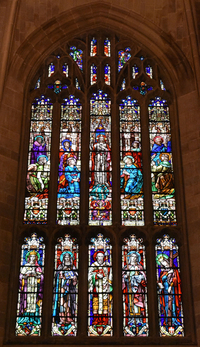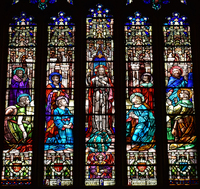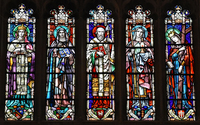Window
Building Name: Cathedral of the Most Blessed SacramentStudio Name: Willet Hauser Architectural Glass
City: Detroit
Window Shape: 6 (gothic arched, more than 2 vertical sections)
Subject/Title of Window: Christ Gives the Apostles the Power to Forgive Sins
Brief Description of Subject: The canopy topping this five panel window is decorative in nature highlighted by angels with a censer.
The scene below is topped with decorative inscriptions based on Matt. 28:4-5 --- the Resurrection scene where the two Mary's had come to anoint the body of Jesus and an angel appeared at the tomb "And for fear of him the guards trembled and became like dead men. But the angel said to the women 'Don't be afraid, for I know you seek Jesus.'" This scene is covered in all four Gospels and differ in only minor details. The inscription is Luke 24:17 and based on the Douay-Rheims Bible; the artist evidently found it necessary to rearrange the words. The "Guide to the Cathedral of the Most Blessed Sacrament" gives an excellent description of the scene (see last paragraph). Just some comments. In the scene, Christ has a chalice in his right hand and bread in his left hand, this is a case of artistic license as in Luke the food was "broiled fish and honeycomb." Finally, after the crucifixion it is unusual for Christ to be depicted without stigmata. Below the scene are decorative coats-of-arms as befitting a Norman styled church as well as an angel holding nails - an instrument of the Passion.
In the lower portion of the window is depicted five saints with the artist's creation of their coat-of-arms.
St Agnes (3rd - 4th Century) During the time of the Diocletian persecutions, a son of a Roman official fell in love with her but she refused to marry him because her only love would be Christ. Spurned, he turned her in for being a Christian and she was martyred. Her main attribute is a lamb -- although there is no single reason why. St. Augustine said that in Latin "Agnes" means "lamb". St Ambrose said that Agnes was called a "lamb" because she was meek and humble like a lamb or perhaps the legend that after her death, her parents saw her standing with a lamb. Other attributes seen here include wearing a crown (reward in heaven), a book (devoted to teachings of Christ in the Gospels) and in her coat-of-arms a red rose (martyrdom) and a shepherd's crook.
St Bridget (Brigid) of Kildare (451 - 525) believed to be a friend of St. Patrick and, like him, is a Patron Saint of Ireland. She was known for her charity and founded a monastery at Kildare becoming its abbess. There is a form of a cross called "Brigid's Cross" which is a cross made out of reeds --- this stems from a story that she was attending to a pagan who was dying and the pagan noticed that she was weaving a cross out of reeds, when she explained the meaning of the cross the pagan asked to be baptized a Christian. Along with the shamrock and a harp, a Brigid's cross is a symbol of Ireland. After her death, the sisters at her monastery started a perpetual fire in her honor which they managed to keep lit for over 400 years. Attributes seen here include costumed in a nun's habit, a monastic crosier (abbess), holding a book with the image of a Brigid's cross, and in her coat-of-arms a lit lamp, what looks like to me, a flower with 4 petals which were called "crucifers as they form a cross and a fish which stems from a legend that a woman sought refuge from a nobleman who had imprisoned her for losing a broach that he had thrown into the sea, Brigid had a fisherman look for it and he caught a fish that had swallowed the broach.
St. Jude (Thaddeus) was a cousin of Jesus and became an Apostle. He preached mainly in Mesopotamia, Syria, and Persia and wrote an Epistle addressed to Hebrew Christians. It is believed that while preaching in Edessa he converted many to Christianity as well as ordaining many priests. It is believed that he was beaten and then beheaded with a polearm. Attributes seen here include dressed in ecclesiastic garments, holding a book with Hebrew writing, holding a polearm and in his coat-of-arms is a lamb with a pennant with a cross (Christ with the victory over death banner) --- I was not able to relate this to St. Jude.
St. Clare of Assisi (1193 -1253) was an early follower of St. Francis of Assisi and founded the "Second Order of St. Francis" more familiarly known as "Poor Clares". She became their abbess at their monastery at Damiano which had been restored by St. Francis. One famous legend relates when their chapel was being attacked by Saracens, St. Clare took the monstrance with the Eucharist and when she showed it to the Saracens they fled in terror. In another story, Clare's mother had a difficult time with Clare's birth and the Holy Spirit told her mother everything would be fine and that the child was to be named "Clare" as she would be a light that would shine the brightest in all the world. Attributes seen here include costumed as an abbess of the Second Order of St. Francis with a processional staff, a monstrance with the blessed heart of Christ in the center, and in the coat-of-arms a descending dove (Holy Spirit) as well as three crosses and a star.
St Helene (250 - 329) was the mother of Constantine -- the Roman Emperor who legalized Christianity and made his mother an empress. She is best known for her trip to the Holy Land and according to legend returned with the Holy Cross as well as the nails used in the crucifixion. She had one of the nails put into the helmet of Constantine and another into the bridle of his horse as protection from harm in battle. Attributes seen here include dressed as an empress with crown, carrying a large wooden cross, reading a book (usually represents humility), and in the coat-of-arms is a cross and what I believe to be a nail that has been shaped into a part from a bridle or possibly a horseshoe.
From the Guide to the Cathedral of the Most Blessed Sacrament, Copyright 1958, Archdiocese of Detroit.
On Easter Sunday evening Christ appeared to His apostles in the upper room where they were hidden behind locked doors. In the central panel Christ holds the chalice in His hands. He has just drunk from it to prove He is not an apparition, but His own authentic self. The apostles occupy the other panels, their faces transfixed with the wonder and joy that the sudden appearance of their Lord has inspired. He has just given them the power to forgive sins. The saints below are St. Agnes, St. Bridget of Sweden, St. Jude, St. Clare, and St. Helen.
Inscriptions: And that Penance should be Preached Remission of Sins
Height: 25'
Width: 12'
Christ Gives the Apostles the Power to Foregive Sins
Christ Gives the Apostles the Power to Foregive Sins, scene
Christ Gives the Apostles the Power to Foregive Sins Saints
The MSGC is a constantly evolving database. Not all the data that has been collected by volunteers has been sorted and entered. Not every building has been completely documented.
All images in the Index are either born-digital photographs of windows or buildings or are scans of slides, prints, or other published sources. These images have been provided by volunteers and the quality of the material varies widely.
If you have any questions, additions or corrections, or think you can provide better images and are willing to share them, please contact donald20@msu.edu





